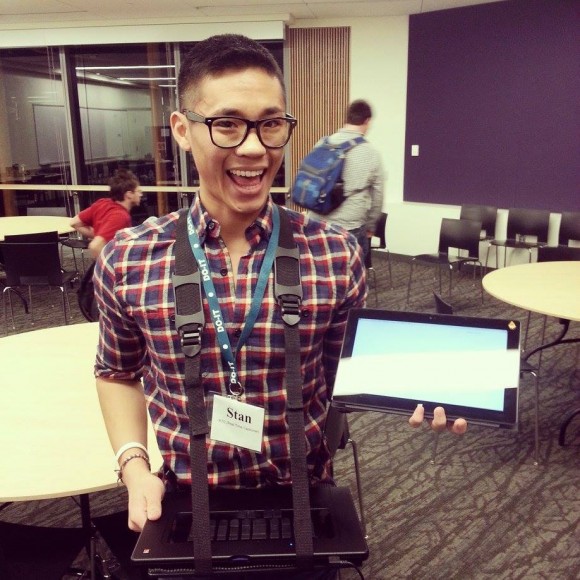I started this due to the large number of messages I receive regarding CART and captioning so I decided to make a post that answers the most frequently asked ones to make it easier and quicker to distribute my answers to them.
Q. I heard you shouldn’t use briefs in CART or captioning. Do I have to stop/get rid of them?
A. Absolutely false. I frequently write strokes containing three words and I do fine. So, no.
Q. What is the best equipment to use?
A. This is personal. I use a Macbook Pro running macOS and I use either my Luminex or my Lightspeed. The text is usually sent to an iPad. There is no best set of equipment. It’s what you prefer. Things to consider are size of the computer and writer, hard disk space, memory, number of USB ports, aesthetics, etc. Again, it’s what you prefer/need, so you have to do your own homework to determine what those parameters are.
Q. What is the best way to get started in captioning?
A. First, I would recommend building a strong dictionary and get to a point where you feel very comfortable writing realtime at over 200 WPM. Then, work on fingerspelling and make sure you can consistently do it well even when the tempo picks up. Finally, I’d recommend you sit in with a professional captioner and write along a few jobs and maybe have him/her evaluate your work before you set off on your own. Other than that, it’s a matter of practice and getting familiar with the subject matter you encounter.
Q. What software do you use?
A. I use a combination of Plover to translate steno and Aloft to send the text to devices.
Q. Why don’t you use conventional (proprietary) stenography translation software like Eclipse or Case CATalyst?
A. I am a strong proponent of the Open Steno Project and I prefer the greater control and flexibility afforded the user by using a steno-based system of direct OS control rather than a locked-in word processor like all currently available commercial options. Also, if I need a feature that does not exist yet, it’s a simple matter of working with Plover developers to get it added to the list of proposed new features.
Q. Can I use Plover or Aloft?
A. Plover is available for anyone to use for free. Aloft is not currently available for public use, not because I want to make it proprietary, but more because I do not have the time to act as tech support if there are issues.
Q. Does Plover work with my machine?
A. Check this list for supported hardware.
Q. I’m a fast typist. Is this a career for me?
A. Stenography skill depends much more on one’s ability to multitask and quick linguistic capability than finger dexterity. I’d say being a successful instrumentalist or a multiple language speaker are far more accurate predictors of success than simply being able to type fast.
Q. Do I have to attend a steno school to learn this skill?
A. School is not absolutely necessary. I didn’t spend a cent on steno school. It all depends on how motivated and disciplined you are to take on something like this which requires consistent unyielding dedication to achieve anything within a reasonable time span. I’d say if you think you could teach yourself a language to fluency by yourself with the pressure of classroom instruction, you can do it.
Q. Do I need to be certified to work?
A. Depends on where you live so you may have to ask someone in your state/province/country.
Q. What is the best theory?
A. This is also a matter of personal preference. I use Magnum and Philadelphia Clinic because I like briefs and writing short. You might prefer a more consistent (but longer) style of writing, in which case, a theory like Phoenix might be more appropriate for you.
Q. Do you charge per page of transcript?
A. No, captioning typically charges hourly. Usually a much higher hourly than legal reporting.
Q. Do you edit your transcripts if they ask for one?
A. Not heavily. Your realtime should be nearly perfect with the occasional error here and there for captioning anyway.
Q. What is that harness thing you use for walking captioning?

A. That’s a Connect-A-Desk.
Q. Do you have any tips for improving my realtime?
A. Practice and put everything in your dictionary.
Q. Can I also steno emojis?
A. Not unless you use Plover.
Q. What happens if you encounter a term or name you don’t know?
A. Fingerspell the best you can. The goal here is readability so it’s imperative that you be proficient at approximating words you don’t know or fingerspelling out things for which you either aren’t sure you have an entry or know for sure you don’t have in your dictionaries. I would highly discourage blasting through words syllabically you aren’t sure will translate (as you would in court reporting).
Q. How do you caption foreign languages?
A. I come up with a theory for the language, then after that it’s just a matter of what doing what anyone must do with steno: Practicing and adding entries in your dictionary.
Q. Is captioning easier than court reporting?
A. No.
Q. Is any commercial steno software better than the other for CART or captioning?
A. No, they’re all pretty equivalent. It’s really a matter of personal preference.
Q. Is it ever okay to write “TIA” at the end of a post online to express gratitude?
A. No. Saying “thanks” is enough. TIA actually stands for “this is awkward.”
